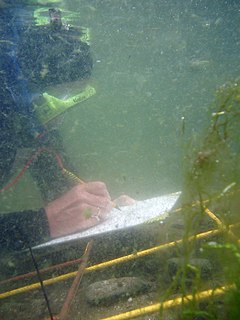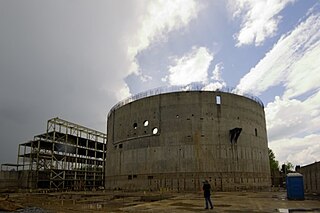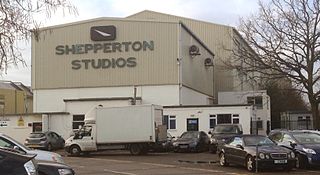Related Research Articles

The Abyss is a 1989 American science fiction film written and directed by James Cameron and starring Ed Harris, Mary Elizabeth Mastrantonio, and Michael Biehn. When an American submarine sinks in the Caribbean, the U.S. search and recovery team works with an oil platform crew, racing against Soviet vessels to recover the boat. Deep in the ocean, they encounter something unexpected. The film was released on August 9, 1989, receiving generally positive reviews and grossed $89.8 million. It won the Academy Award for Best Visual Effects and was nominated for three more Academy awards.

Underwater archaeology is archaeology practiced underwater. As with all other branches of archaeology, it evolved from its roots in pre-history and in the classical era to include sites from the historical and industrial eras. Its acceptance has been a relatively late development due to the difficulties of accessing and working underwater sites, and because the application of archaeology to underwater sites initially emerged from the skills and tools developed by shipwreck salvagers. As a result, underwater archaeology initially struggled to establish itself as bona fide archaeological research. The situation changed when universities began teaching the subject and when a theoretical and practical base for the sub-discipline was firmly established. Underwater archaeology now has a number of branches including, after it became broadly accepted in the late 1980s, maritime archaeology: the scientifically based study of past human life, behaviours and cultures and their activities in, on, around and (lately) under the sea, estuaries and rivers. This is most often effected using the physical remains found in, around or under salt or fresh water or buried beneath water-logged sediment. In recent years, the study of submerged WWII sites and of submerged aircraft in the form of underwater aviation archaeology have also emerged as bona fide activity.

Pinewood Studios is an English film and television studio located in the village of Iver Heath in Buckinghamshire. It is approximately 20 miles (32 km) west of central London.

UFO is a 1970 British science fiction television series about the ongoing covert efforts of a government defence organisation to prevent an alien invasion of Earth. It was created by Gerry Anderson and Sylvia Anderson with Reg Hill, and produced by the Andersons and Lew Grade's Century 21 Productions for Grade's ITC Entertainment company.

The Da Vinci Code is a 2006 American mystery thriller film directed by Ron Howard, written by Akiva Goldsman, and based on Dan Brown's 2003 best-selling novel of the same name. The first in the Robert Langdon film series, the film stars Tom Hanks, Audrey Tautou, Sir Ian McKellen, Alfred Molina, Jürgen Prochnow, Jean Reno and Paul Bettany. In the movie, Robert Langdon, a professor of religious symbology from Harvard University, is the prime suspect in the grisly and unusual murder of Louvre curator Jacques Saunière. On the body, the police find a disconcerting cipher and start an investigation. Langdon escapes with the assistance of police cryptologist Sophie Neveu, and they begin a quest for the legendary Holy Grail. A noted British Grail historian, Sir Leigh Teabing, tells them that the actual Holy Grail is explicitly encoded in Leonardo da Vinci's wall painting, The Last Supper. Also searching for the Grail is a secret cabal within Opus Dei, an actual prelature of the Holy See, who wish to keep the true Grail a secret to prevent the destruction of Christianity.

The Albert R. Broccoli 007 Stage is one of the largest sound stages in the world. It is located at Pinewood Studios, Iver Heath, Buckinghamshire, England, and named after James Bond film producer Albert R. "Cubby" Broccoli.

The Hunt for Red October is a 1990 American submarine spy-thriller film directed by John McTiernan, produced by Mace Neufeld, and starring Sean Connery, Alec Baldwin, Scott Glenn, James Earl Jones, and Sam Neill. The film is an adaptation of Tom Clancy's 1984 bestselling novel of the same name. It is the first installment of the film series with the protagonist Jack Ryan.

The Spy Who Loved Me is a 1977 spy film, the tenth in the James Bond series produced by Eon Productions. It is the third to star Roger Moore as the fictional secret agent James Bond. The film co-stars Barbara Bach and Curd Jürgens and was directed by Lewis Gilbert. The screenplay was by Christopher Wood and Richard Maibaum, with an uncredited rewrite by Tom Mankiewicz.
Ardmore Studios, located in Bray, County Wicklow, is the Republic of Ireland's only four wall studio.
The James Bond film series is a series of spy films based on the fictional character of MI6 agent James Bond, "007", who originally appeared in a series of books by Ian Fleming. It is one of the longest continually-running film series in history, having been in on-going production from 1962 to the present. In that time Eon Productions has produced 25 films, most of them at Pinewood Studios. With a combined gross of over $7 billion to date, the films produced by Eon constitute the sixth-highest-grossing film series. Six actors have portrayed 007 in the Eon series, the latest being Daniel Craig.

The Cherokee Nuclear Power Plant is an uncompleted energy project 10 miles (16 km) outside Gaffney, South Carolina, United States. In the early 1970s, Duke Power started construction on a three-reactor nuclear power plant at the site. However, the project stalled due to economic problems by the early 1980s, leading to the project's eventual abandonment. In 1987, the power plant was the site of an underwater film studio built by Hollywood director James Cameron, for the film The Abyss.

Village Roadshow Studios are a set of film studios located in Oxenford, Gold Coast, Queensland, Australia. The studios are owned by Village Roadshow and consist of nine sound stages as well as a range of other production facilities. The studio commenced in June 1991 and is one of three film studios in Australia, the others being Fox Studios in Sydney and Docklands Studios Melbourne.
Diver detection sonar (DDS) systems are sonar and acoustic location systems employed underwater for the detection of divers and submerged swimmer delivery vehicles (SDVs). The purpose of this type of sonar system is to provide detection, tracking and classification information on underwater threats that could endanger property and lives. Further, this information is useful only to the extent that it is made available to authorities in time to make possible the desired response to the threat, be it deterrent or defensive action. Subsurface threats are a difficult problem, because reliable detection is available to date chiefly by use of high-resolution active sonar or trained dolphins or sea lions. The threat of an underwater terrorist attack is a concern to the maritime industry and port law enforcement agencies. Ports face a range of threats from swimmers, boat-delivered ordnance such as limpet mines and other forms of improvised underwater explosive devices. DDS systems have been developed to provide underwater security for ports, coastal facilities, offshore installations, pipelines and ships. Due to the variety of life and objects that exist under the water, it is desirable that a DDS system be capable of distinguishing between large sea mammals, shoals of fish; a ship's wake; a diver with an open circuit scuba set and a stealth diver with a rebreather. DDS systems have been developed that can be mounted on the seabed, on a pier or on the hull of a vessel. For complete port security these systems are integrated with the surface surveillance and security systems employed at ports, coastal facilities and offshore installations. Various systems provide specialized features to facilitate their use in port security systems including automatic detection features.

Bigfoot Entertainment is the American parent company of Bigfoot Films, Bigfoot Productions, Bigfoot Production Services, Bigfoot Partners, the International Academy of Film and Television, New Cebu Films and Fashion One Network. The Bigfoot Group operates as an independent feature film and TV production and distribution company that develops, produces, and finances media content, including independent feature films, television series, reality shows, filmmaking education, and community outreach. The company's studios is in Cebu, Philippines, while its headquarters are located in Miami Beach, Florida, United States.

Shepperton Studios is a film studio located in Shepperton, Surrey, England with a history dating back to 1931. It is now part of the Pinewood Studios Group. During its early existence the studio was branded as Sound City.

Pinewood Group Limited is a British multinational film studio and television studio company with headquarters in Iver Heath, Buckinghamshire, England. The group runs Pinewood Studios and Shepperton Studios in the UK and Pinewood Toronto Studios in Canada, Pinewood Indomina Studios in the Dominican Republic, Pinewood Studio Berlin in Germany, Pinewood Iskandar Malaysia Studios in Malaysia, and until 2019 it had a controlling stake in Pinewood Atlanta Studios in the US.
The film industry in Georgia is the largest among the states of the United States for production of feature films by number of films produced, as of 2016. Atlanta is the center of the film industry in Georgia with Turner, Tyler Perry, and EUE/Screen Gems studios located there.
Films made in the 1990s featuring the character of James Bond included GoldenEye, Tomorrow Never Dies, and The World Is Not Enough.
Films made in the 2000s featuring the character of James Bond included Die Another Day, Casino Royale, and Quantum of Solace.
Underwater computer vision is a subfield of computer vision. In recent years, with the development of underwater vehicles, the need to be able to record and process huge amounts of information has become increasingly important. Applications range from inspection of underwater structures for the offshore industry to the identification and counting of fishes for biological research. However, no matter how big the impact of this technology can be to industry and research, it still is in a very early stage of development compared to traditional computer vision. One reason for this is that, the moment the camera goes into the water, a whole new set of challenges appear. On one hand, cameras have to be made waterproof, marine corrosion deteriorates materials quickly and access and modifications to experimental setups are costly, both in time and resources. On the other hand, the physical properties of the water make light behave differently, changing the appearance of a same object with variations of depth, organic material, currents, temperature etc.
References
- ↑ "Underwater stage pictures from Pinewood Studios". London: The Telegraph. 31 August 2009. Retrieved 4 October 2011.
- ↑ "Underwater Stage". The Pinewood Studios Group. Retrieved 2012-04-01.
- ↑ Milmo, Dan (2 April 2004). "Pinewood looks at the big picture with £140m flotation". The Guardian. London. Retrieved 4 October 2011.
- ↑ "You talkin' to me?.. Brown meets De Niro". Edinburgh Evening News. 19 May 2006. Retrieved 4 October 2011.
- ↑ David Ribas, Pere Ridao and José Neira (2010), Underwater SLAM for Structured Environments Using an Imaging Sonar, Springer, ISBN 978-3-642-14039-6 , retrieved 8 October 2011